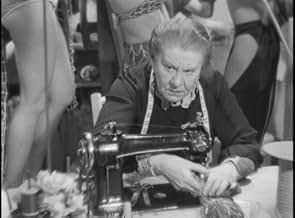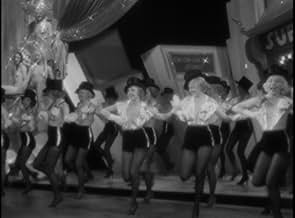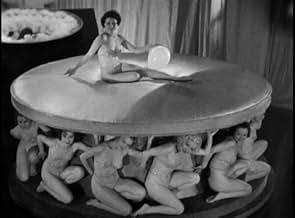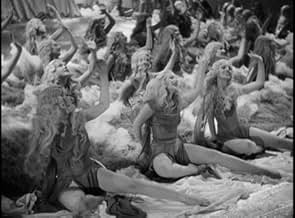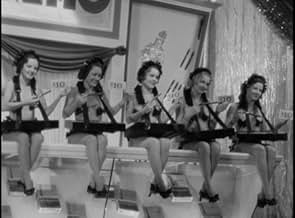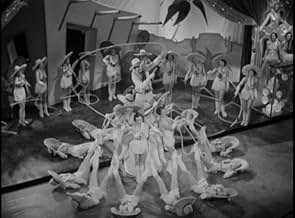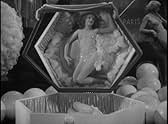Agrega una trama en tu idiomaA homicide detective with an eye for the ladies, investigating a murder in Earl Carroll's Vanities, allows the music revue to continue during the investigation.A homicide detective with an eye for the ladies, investigating a murder in Earl Carroll's Vanities, allows the music revue to continue during the investigation.A homicide detective with an eye for the ladies, investigating a murder in Earl Carroll's Vanities, allows the music revue to continue during the investigation.
- Dirección
- Guionistas
- Elenco
- Premios
- 1 premio ganado en total
Charles Middleton
- Homer Boothby
- (as Charles B. Middleton)
Ernestine Anderson
- Earl Carroll Girl
- (sin créditos)
Lona Andre
- Lona - Earl Carroll Girl
- (sin créditos)
William Arnold
- Treasurer
- (sin créditos)
Lucille Ball
- Earl Carroll Girl
- (sin créditos)
Lucille Battle
- Black Dancer in Ebony Rhapsody number
- (sin créditos)
Opiniones destacadas
I just viewed MURDER AT THE VANITIES in the newly-released Universal Pre-Code set, and I was amazed at how much I enjoyed the vehicle end to end. Most of the other commentators have covered the story, a murder mystery within a musical, but I wanted to add a few additional notes. Brisson and Carlisle are relatively bland, compared to even most of the minor players, and neither one really seems to have the proper voice for what they're singing (Carlisle being a trained opera singer, Brisson a bit wobbly on some of his high and low notes). The great Victor McLaglen and Jack Oakie play well off each other, with an excellent sense of timing that keeps the ball rolling between musical numbers. Yes, Lucille Ball and Ann Sheridan are Vanities girls, but let's not forget the splendid jazz singer Ernestine Anderson in the "Ebony Rhapsody" number. Gail Patrick makes one of her early appearances, sounding a bit like Eve Arden; Patrick would go on to become the executive producer of the Perry Mason TV series. Then there's Jessie Ralph as the wardrobe mistress--you'll spot her also in David COPPERFIELD (as Aunt Peggoty) and THE BANK DICK. The music is very good--Brisson introducing the standard "Cocktails for Two" in two different scenes; "Sweet Marihuana" with barely clad peyote button girls in the background (blood dripping on one chorine's white skin was wonderfully chilling); the "Ebony Rhapsody," with Duke Ellington's Orchestra and a bevy of beautiful dancers, both black and white, mixing it up. And I believe this is one of the only early musicals to feature such a mix--and the costumes leave nothing to the imagination.
A fast-paced murder mystery set backstage at a performance of Earl Carroll's Vanities.
It's clear the filmmakers' primary motivation was to showcase the Vanities and realized they needed to wrap a movie around it. Far more screen time is given to the lavish musical numbers featuring countless scantily clad women than to the mechanics of the nominal plot, but that's not a criticism. It's rather fascinating to see this unique brand of stage entertainment captured in all its antiquated glory, and honestly the women are more interesting to watch than the story anyway. And though this is mostly a disposable B movie, it really does come alive in a special way during some of the musical moments, and some of the magic of seeing this kind of show performed live is captured on screen.
The cast includes an appealing Kitty Carlisle and a humorous Victor McLaglen, right before he was to win an Oscar for John Ford's "The Informer." Duke Ellington also makes a cameo.
Pretty fun stuff.
Grade: B+
It's clear the filmmakers' primary motivation was to showcase the Vanities and realized they needed to wrap a movie around it. Far more screen time is given to the lavish musical numbers featuring countless scantily clad women than to the mechanics of the nominal plot, but that's not a criticism. It's rather fascinating to see this unique brand of stage entertainment captured in all its antiquated glory, and honestly the women are more interesting to watch than the story anyway. And though this is mostly a disposable B movie, it really does come alive in a special way during some of the musical moments, and some of the magic of seeing this kind of show performed live is captured on screen.
The cast includes an appealing Kitty Carlisle and a humorous Victor McLaglen, right before he was to win an Oscar for John Ford's "The Informer." Duke Ellington also makes a cameo.
Pretty fun stuff.
Grade: B+
This murder mystery with musical numbers is long on atmosphere and character but rather short on suspense and plausibility. Based on a stage play by Broadway showman Earl Carroll and others, it combines a whodunit plot with a backstage ambiance (a homicide investigation takes place on opening night at the theatre where a musical revue is being staged).
The cast is impressive and varied: tough-goofy Victor McLaglen as the police officer who leads the investigation and never fails to leer idiotically at whatever showgirl happens to be in sight; Jack Oakie (the prewar Jack Lemmon – or was Jack Lemmon the postwar Jack Oakie?) as the harassed director who must coordinate the staged performance as well as the chaos behind the scenes; the ever-homely Jessie Ralph as a wardrobe mistress with deep, dark secrets; Dorothy Stickney, who has a stunning close-up monologue near the end, as the tremulous maid madly in love with the male lead; Carl Brisson, the Danish star, as that very male lead, warbling the classic "Cocktails for Two" not once but twice; Kitty Carlisle, operatically delivering "Where Do They Come from and Where Do They Go" and other Johnston-Coslow songs; the glorious Gertrude Michael, who parted from us too soon, as a mean-spirited showgirl whose love for Brisson is spurned; the usually ridiculous Toby Wing who here at least is the center of a laugh-getting running joke.
When the plot complications get out of hand there is always an interesting performer or fun and tuneful musical number to distract the viewer. The film's most celebrated sequence is the "Marahuana" number, led by Michaels, but aside from its controversial history, it's really one of the lesser musical offerings. All of the songs here are staged as if they could actually have fit into a standard proscenium theatre space, as opposed to the cinematic fantasy setup of the Busby Berkeley style.
The cast is impressive and varied: tough-goofy Victor McLaglen as the police officer who leads the investigation and never fails to leer idiotically at whatever showgirl happens to be in sight; Jack Oakie (the prewar Jack Lemmon – or was Jack Lemmon the postwar Jack Oakie?) as the harassed director who must coordinate the staged performance as well as the chaos behind the scenes; the ever-homely Jessie Ralph as a wardrobe mistress with deep, dark secrets; Dorothy Stickney, who has a stunning close-up monologue near the end, as the tremulous maid madly in love with the male lead; Carl Brisson, the Danish star, as that very male lead, warbling the classic "Cocktails for Two" not once but twice; Kitty Carlisle, operatically delivering "Where Do They Come from and Where Do They Go" and other Johnston-Coslow songs; the glorious Gertrude Michael, who parted from us too soon, as a mean-spirited showgirl whose love for Brisson is spurned; the usually ridiculous Toby Wing who here at least is the center of a laugh-getting running joke.
When the plot complications get out of hand there is always an interesting performer or fun and tuneful musical number to distract the viewer. The film's most celebrated sequence is the "Marahuana" number, led by Michaels, but aside from its controversial history, it's really one of the lesser musical offerings. All of the songs here are staged as if they could actually have fit into a standard proscenium theatre space, as opposed to the cinematic fantasy setup of the Busby Berkeley style.
Rarely has a movie mixed as many unlikely co-stars -- and genres -- as "Murder at the Vanities." Mixed up in the mystery of who slew a brunette in Earl Carroll's rafters are brash, beaming Jack Oakie, wooden European crooner Carl Brisson, Kitty Carlisle (long before "To Tell the Truth,") Victor McLaglen as a burly flatfoot whose accent suggests he just emigrated from Dublin and Dorothy Stickney who would go on to appear in Broadway's longest-running hit, "Life with Father." My vote for outstanding performance is Stickney as the dim-witted maid whose hysterics are worth the price of admission. Then again, so are the scantily clad chorines garbed in not much more than gossamer just before the Production Code came in.
A Murder investigation goes on back stage while The Vanities, on its opening night, plays on to an unknowing audience. Odd combination of musical and murder mystery is worth a look for its cast, its terrific production numbers, and the sheer novelty of the film.
Gertrude Michael has the showy role of a bitchy actress intent on stopping the marriage between the show's stars, Kitty Carlisle and Carl Brisson, as well as starring in the infamous "Sweet Marijuana" number (which was also on a 70s Bette Midler album). So while the chorus girls shuffle around backstage, bumbling detective Victor McLaglen ogles the girls while he tries to solve the backstage murder of an unknown woman whose body is found on a catwalk above the stage.
We quickly learn that the maid (Dorothy Stickney) loves Brisson from afar, that the wardrobe lady (Jessie Ralph) is Brisson's mother, and that the stage manager (Jack Oakie) butts into everything. Lots of plots twists among the musical numbers. The show's best-known song is "Cocktails for Two" sung by Brisson and Carlisle. They also sing "Live and Love Tonight" on a tropical isle surrounded by showgirls waving feather fans to simulate the ocean. Carlisle also sings the haunting "Where Do They Come From?" Gertrude Michael sings the infamous "Sweet Marijuana." And there's a weird rhapsody that erupts into a Harlem specialty number featuring Duke Ellington!
Some terrific acting here, especially Gertrude Michael and Dorothy Stickney. Kitty Carlisle is quite good as well. Brisson, Oakie, and McLaglen are all solid.
Charles Middleton plays Homer, Toby Wing plays Nancy, Donald Meek plays the doctor, Gail Patrick plays the unknown woman, and see if you can spot Ann Sheridan, Alan Ladd and Lucille Ball among the chorus members.
Gertrude Michael has the showy role of a bitchy actress intent on stopping the marriage between the show's stars, Kitty Carlisle and Carl Brisson, as well as starring in the infamous "Sweet Marijuana" number (which was also on a 70s Bette Midler album). So while the chorus girls shuffle around backstage, bumbling detective Victor McLaglen ogles the girls while he tries to solve the backstage murder of an unknown woman whose body is found on a catwalk above the stage.
We quickly learn that the maid (Dorothy Stickney) loves Brisson from afar, that the wardrobe lady (Jessie Ralph) is Brisson's mother, and that the stage manager (Jack Oakie) butts into everything. Lots of plots twists among the musical numbers. The show's best-known song is "Cocktails for Two" sung by Brisson and Carlisle. They also sing "Live and Love Tonight" on a tropical isle surrounded by showgirls waving feather fans to simulate the ocean. Carlisle also sings the haunting "Where Do They Come From?" Gertrude Michael sings the infamous "Sweet Marijuana." And there's a weird rhapsody that erupts into a Harlem specialty number featuring Duke Ellington!
Some terrific acting here, especially Gertrude Michael and Dorothy Stickney. Kitty Carlisle is quite good as well. Brisson, Oakie, and McLaglen are all solid.
Charles Middleton plays Homer, Toby Wing plays Nancy, Donald Meek plays the doctor, Gail Patrick plays the unknown woman, and see if you can spot Ann Sheridan, Alan Ladd and Lucille Ball among the chorus members.
¿Sabías que…?
- TriviaMany of the Earl Carroll Girls featured in the film were authentic cast members from Carroll's stage show, which ran from September 12th to November, 1933, at the New Amsterdam Theatre, and at the Majestic Theatre from November 6th, 1933 to March 10th, 1934. These cast members were brought out to Hollywood from New York especially for this film, and many stayed to pursue film careers.
- ErroresWhen the body of the woman on the catwalk is turned on her back, you can see the actress' chest rise and fall as she takes a breath.
- Citas
[last lines]
Jack Ellery: Nancy, what shall I do?
Nancy: Oh, Mr. Ellery!
Jack Ellery: C'mon, let's do it.
- ConexionesEdited into The Big Broadcast of 1937 (1936)
- Bandas sonorasEbony Rhapsody
(uncredited)
by Arthur Johnston and Sam Coslow
Sung by Carl Brisson, Kitty Carlisle and Gertrude Michael
Selecciones populares
Inicia sesión para calificar y agrega a la lista de videos para obtener recomendaciones personalizadas
- How long is Murder at the Vanities?Con tecnología de Alexa
Detalles
- Fecha de lanzamiento
- País de origen
- Idioma
- También se conoce como
- Tajne Varijetea
- Locaciones de filmación
- Productora
- Ver más créditos de la compañía en IMDbPro
- Tiempo de ejecución1 hora 29 minutos
- Color
- Relación de aspecto
- 1.37 : 1
Contribuir a esta página
Sugiere una edición o agrega el contenido que falta

Principales brechas de datos
By what name was Murder at the Vanities (1934) officially released in India in English?
Responda

